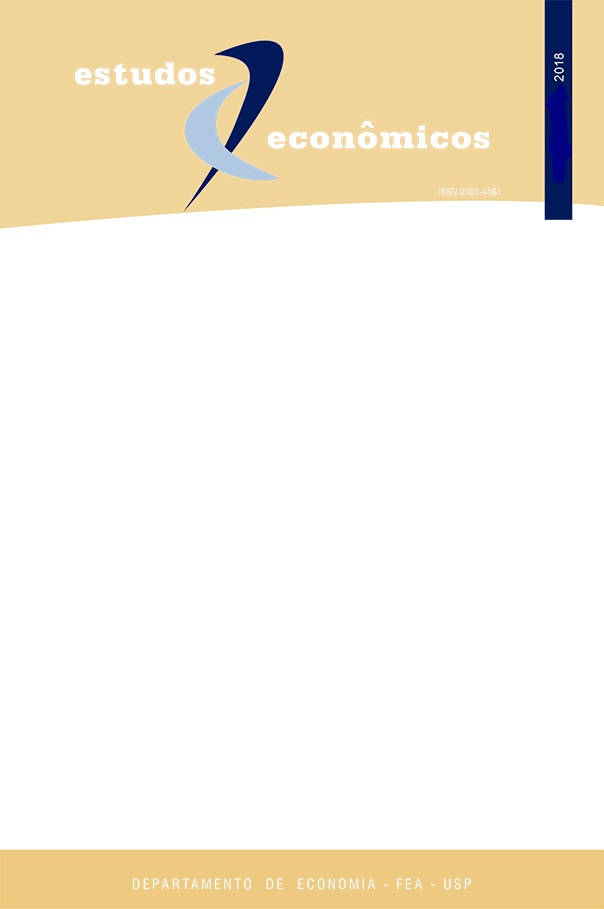Sobre o custo do tempo para a competitividade da indústria brasileira: diagnóstico e síntese dos impactos econômicos da facilitação do comércio no Brasil
DOI:
https://doi.org/10.1590/0101-41614844lfrPalavras-chave:
Facilitação de comércio, Indústria, Equilíbrio GeralResumo
Este artigo analisa a importância dos atrasos portuários para a competitividade da indústria de transformação no Brasil. Com base em estimativas recentes sobre o custo diário dos atrasos comerciais e em bases de dados do Banco Mundial e do GTAP (Global Trade Analysis Project), revela a magnitude destas barreiras sob a forma de seus equivalentes ad valorem. Em seguida, por meio de simulações em equilíbrio geral, estima o impacto da melhoria dos processos aduaneiros sobre o desempenho da indústria de transformação no Brasil, sob diferentes cenários. Os resultados obtidos ressaltam o caráter estratégico da facilitação do comércio para a economia Brasileira, em particular sua indústria de transformação e sua inclusão como item relevante para a agenda de crescimento de longo prazo do país.
Downloads
Referências
Anderson, J. 1979. “A Theoretical Foundation for the Gravity Equation”. American Economic Review 69(1): 106-116.
Anderson, J., Wincoop, E. V. 2003. “Gravity and Gravitas: A Solution to the Border Puzzle”. American Economic Review 93(1): 170-192.
APEC. 1999. “Assessing APEC Trade Liberalization and Facilitation - 1999 update”. Technical report, APEC Economic Committee, Singapore.
Armington, P.S. 1969. “A Theory of Demand for Products Distinguished by Place of Production”. Staff Papers, IMF 16(1): 159-178.
Brockmeier, M. 1996. “A Graphical Exposition of the GTAP model”. GTAP Technical/Paper/No.8.www.gtap.agecon.purdue.edu/resources/res_display.asp?RecordID=31.
Dee, P. 1998. “The Comprehensiveness of APEC’s Free Trade Commitment”. Session VIII in The Economic Implications of Liberalizing, Publication 3101, US International Trade Comission, Washington, D.C.
Dennis, A. and Shepherd, B. 2011. “Trade facilitation and export diversification”. The World Economy, 34(1):101–122.
Dixon, P. B., Pearson, K. 1992. “Notes and Problems in Applied General Equilibrium Economics”. North-Holland Amsterdam.
Dixon, P. B., Jorgenson, D. W. 2013. “Handbook of Computable General Equilibrium Modeling”. North-Holland, vol.B.
Djankov , S., Freund, C., Pham, C.S. 2010. “Trading on Time”. The Review of Economics and Statistics 92(1): 166-173.
Francois, J., Meijl, H. V., Tongeren, F.V. 2003. “Economic Benefits of the Doha Round for the Netherlands”. Project Report, Agricultural Economics Research Institute, La Haye.
Fugazza, M., Maur, J.C. 2008. “Non-tariff barriers in CGE models: How useful for policy?”. Journal of Policy Modeling 30(3): 475-490.
Ginsburgh, V., Keyzer, M. 1997. “The Structure of Applied General Equilibrium Models”. The MIT Press.
Hertel, T. W. 1997. “Global trade analysis: modeling and applications”. Cambridge university press.
Hertel, T. W., Walmsley, T. L., Itakura, K. 2001. “Dynamic Effects of the “New-Age” Free Trade Agreement Between Japan and Singapore”. Journal of Economic Integration 16(4): 446-8.
Hummels, D., Schaur, G. 2013. “Time as a Trade Barrier”. American Economic Review 103(7).
Iwanow, T., Kirkpatrick, C. 2007. “Trade Facilitation, Regulatory Quality and Export Performance”. Journal of International Development 19(6): August, 735–753.
Minor, P., Tsigas, M. 2008. “Impacts of Better Trade Facilitation in Developing Countries”. 11th Annual GTAP Conference, Helsinki, Finland, 12-14, June.
Nordas, H., Piermartini, R. 2004. “Infrastructure and Trade”. WTO Economic Research and Statistics Division. Staff Working Paper ERSD-2004-04, WTO, Geneva.
OECD. 2003. “Quantitative Assessment of the Benefits of Trade Facilitation”. Working Party of the Trade Committee, TD/TC/WP31.
Persson, M. 2008. “Trade Facilitation and the EU-ACP Economic Partnership Agreements”. Journal of Economic Integration 23(3):518–546.
Zhang, J., Fung, H. 2006. “Winners and Losers: Assessing the Impact of Chinese Yuan Appreciation”. Journal of Policy Modeling, Elsevier 28(9): 995-1009.
Yotov, Y.V., Piermartini, J., Monteiro, J.A., Larch, M. 2016. “An Advanced Guide to Trade Policy Analysis: The Structural Gravity Model”. Co-published by Unctad and WTO.
Wilson, J.S., Mann, C.L., Otsuki, T. 2005. “Assessing the Benefits of Trade Facilitation: A Global Perspective”. The World Economy 28(6): June, 841-871.
World Trade Organization. 2015. “Speeding up Trade: Benefits and Challenges of Implementing the WTO Trade Facilitation Agreement”. World Trade Report, 2015.
Downloads
Publicado
Edição
Seção
Licença
Copyright (c) 2018 Estudos Econômicos (São Paulo)

Este trabalho está licenciado sob uma licença Creative Commons Attribution-NonCommercial 4.0 International License.
A submissão de artigo autoriza sua publicação e implica o compromisso de que o mesmo material não esteja sendo submetido a outro periódico.
A revista não paga direitos autorais aos autores dos artigos publicados.
O detentor dos direitos autorais da revista é o Departamento de Economia da Faculdade de Economia, Administração, Contabilidade e Atuária da Universidade de São Paulo.




